The HTC One (M8) Review
by Anand Lal Shimpi & Joshua Ho on March 26, 2014 7:00 PM EST- Posted in
- Smartphones
- HTC
- Mobile
- HTC One
Snapdragon 801 Performance
The M8 is the first smartphone we’ve tested to use Qualcomm’s newly announced Snapdragon 801 SoC. At a high level the 801 is a frequency bump enabled by a 28nm HPm process push, giving it a tangible increase in performance (and potential decrease in power consumption) compared to the outgoing Snapdragon 800. The table below compares the 801 variants to the Snapdragon 800:
| Snapdragon 800/801 Breakdown | ||||||||||
| SoC Version | Model | Max CPU Frequency | Max GPU Frequency | ISP | eMMC | DSDA | Memory IF | |||
| MSM8974VV | v2 | S800 | 2.2GHz | 450MHz | 320MHz | 4.5 | N | 800MHz | ||
| MSM8974AA | v2 | S800 | 2.3GHz | 450MHz | 320MHz | 4.5 | N | 800MHz | ||
| MSM8974AB | v2 | S800 | 2.3GHz | 550MHz | 320MHz | 4.5 | N | 933MHz | ||
| MSM8974AA | v3 | S801 | 2.3GHz | 450MHz | 320MHz | 5.0 | Y | 800MHz | ||
| MSM8974AB | v3 | S801 | 2.3GHz | 578MHz | 465MHz | 5.0 | Y | 933MHz | ||
| MSM8974AC | v3 | S801 | 2.5GHz | 578MHz | 465MHz | 5.0 | Y | 933MHz | ||
In most parts of the world the M8 will ship with a 2.3GHz Snapdragon 801. In Asia/China however we’ll see the 2.5GHz MSM8974AC v3 SKU instead.
Compared to the outgoing Snapdragon 800, peak CPU performance shouldn’t increase all that much. What we may see however is an improvement in power efficiency thanks to the improved 28nm HPm process.
It’s really the GPU that will see the largest increase in performance. With a maximum speed of 578MHz and paired with faster LPDDR3-1866 memory, we should see up to a 30% increase in GPU bound performance over Snapdragon 800 designs.
- Physics
| Snapdragon 801 vs 800 vs 600 | |||||||
| HTC One (M8) - Snapdragon 801 | Google Nexus 5 - Snapdragon 800 | HTC One (M7) - Snapdragon 600 | 801 vs 800 | 801 vs 600 | |||
| SunSpider 1.0.2 | 772.8 ms | 686.9 ms | 1234.8 ms | -12% | +37% | ||
| Kraken Benchmark 1.1 | 6745.2 ms | 7245.9 ms | 12166.5 ms | +7.4% | +45% | ||
| Google Octane v2 | 4316 | 3726 | 3103 | +16% | +39% | ||
| WebXPRT Overall | 373 | 392 | 244 | -5% | +53% | ||
| AndEBench - Native | 17430 | 17480 | 12381 | -1% | +41% | ||
| 3DMark 1.1 Ultimate | 19631 | 17529 | 10519 | +12% | +87% | ||
| 3DMark 1.1 Ultimate - Physics | 50.5 | 51 | 33.1 | -1% | +53% | ||
| Basemark X 1.1 - HQ | 12194 | 11275 | 4807 | +8.1% | +154% | ||
| GFXBench 3.0 - Manhattan Onscreen | 11.1 fps | 9.3 fps | 5.1 fps | +19% | +118% | ||
| GFXBench 3.0 - Manhattan Offscreen | 10.4 fps | 8.7 fps | 4.4 fps | +20% | +136% | ||
| GFXBench 3.0 - T-Rex HD Onscreen | 29.9 fps | 24.3 fps | 12.6 fps | +23% | +137% | ||
| GFXBench 3.0 - T-Rex HD Offscreen | 27.9 fps | 22.9 fps | 12.6 fps | +22% | +121% | ||
CPU Performance
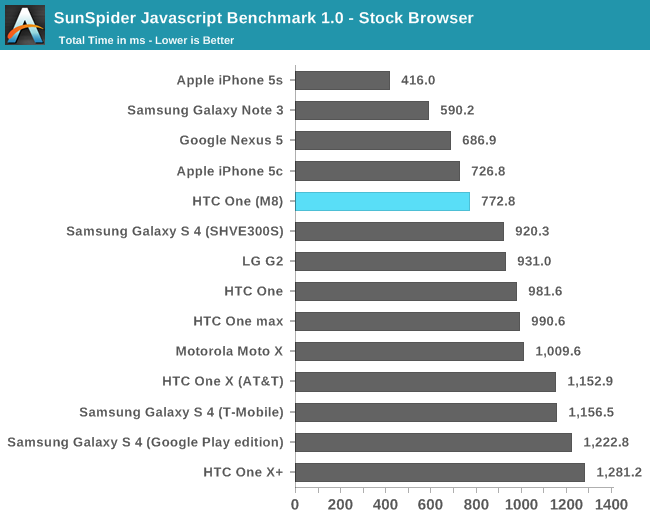
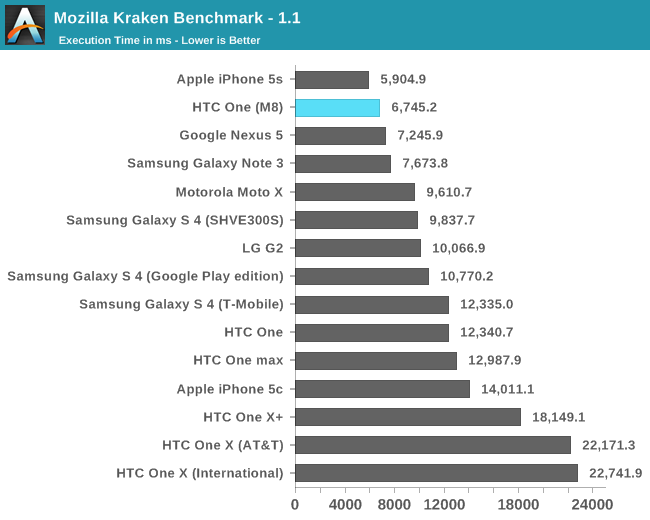
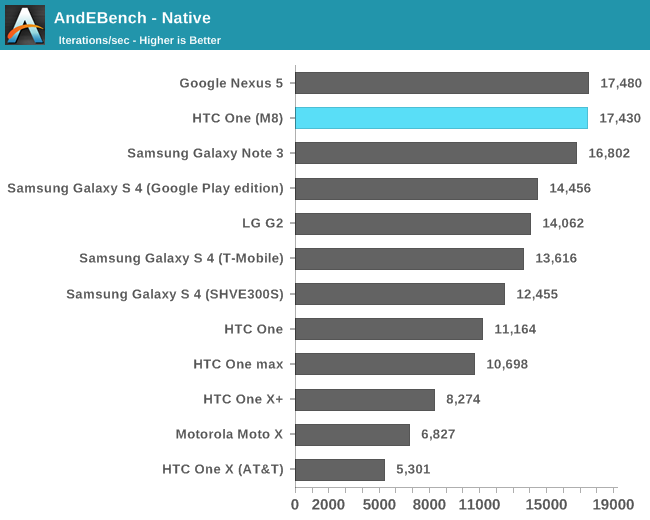
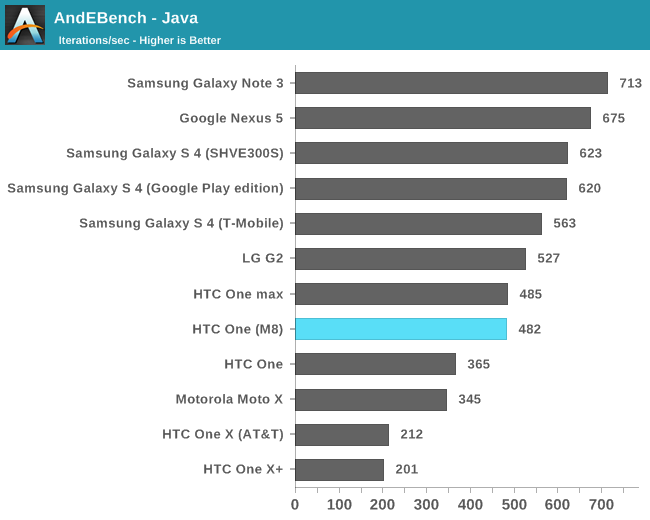
GPU Performance
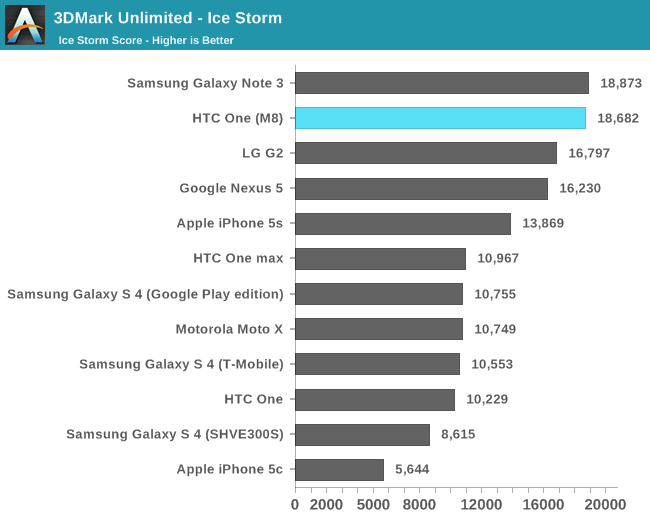
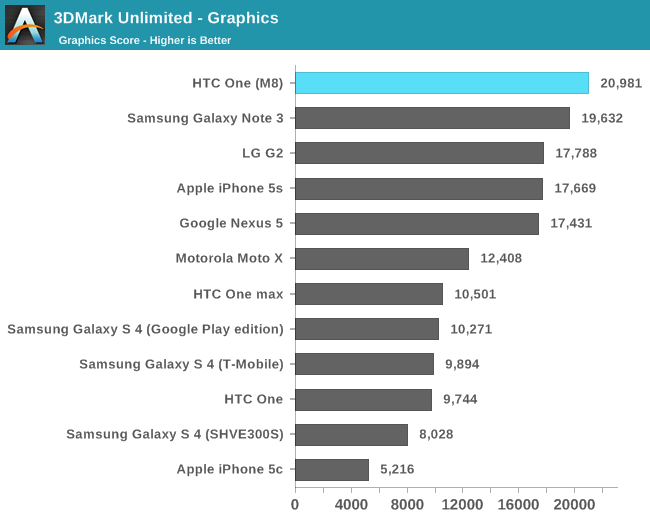
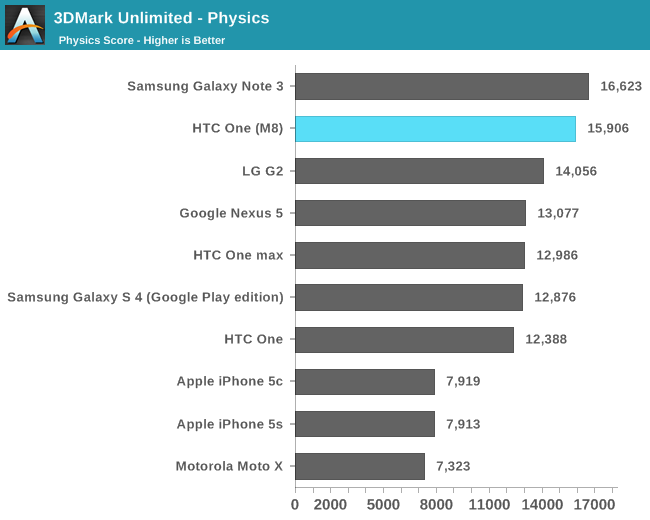
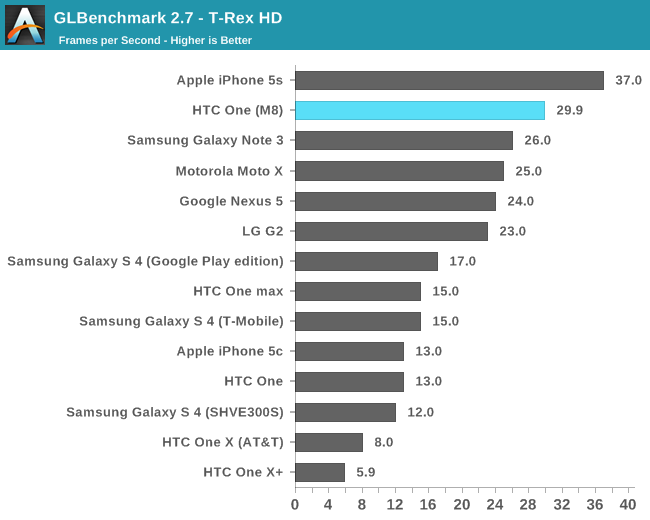
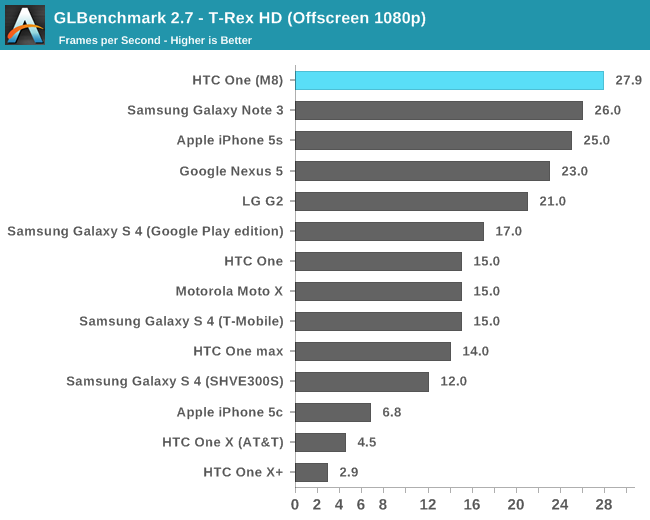
NAND Performance
The One is available in either 16GB or 32GB configurations, there are no higher capacity versions offered. There is now a micro SD card slot on the right side of the device, just above the volume rocker.
Despite using a Snapdragon 801 SoC, the internal storage is still an eMMC 4.5 solution.
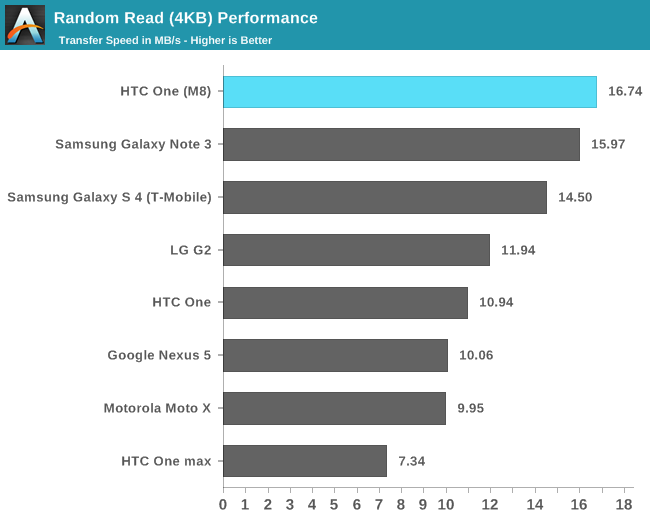
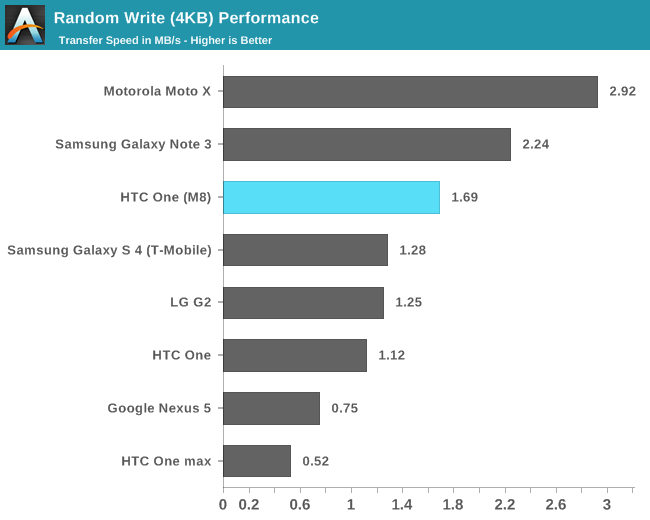

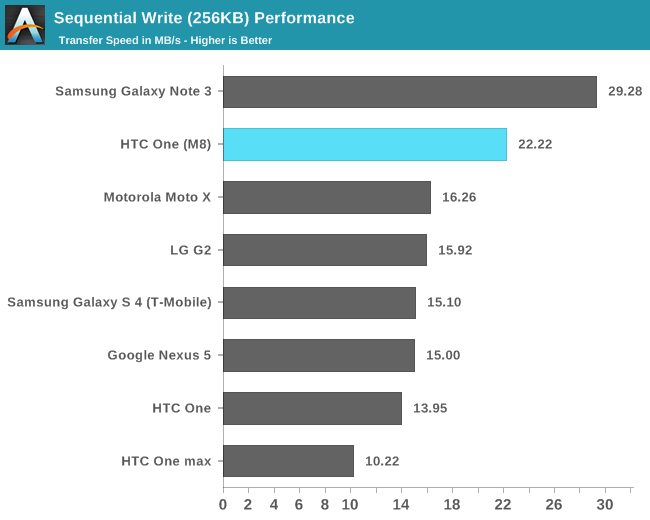


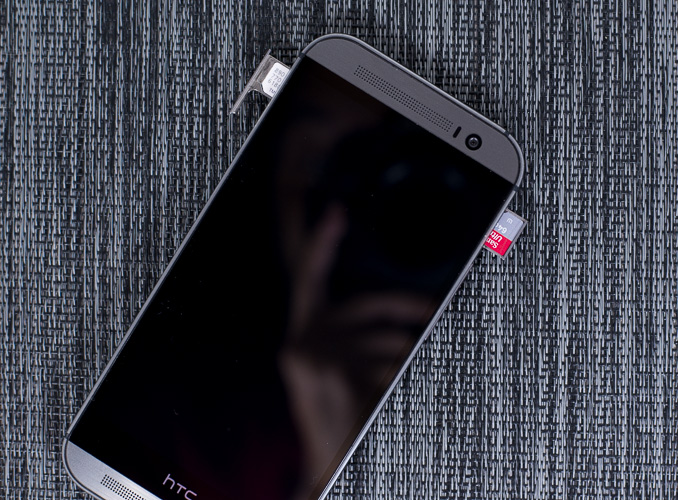








222 Comments
View All Comments
nerdstalker - Thursday, March 27, 2014 - link
It could have been a good move by Brian if he updated his info on Twitter, LinkedIn etc, to reflect any changes (if there is) to his affiliation with AnandTech. A short "thank you, good luck and btw we left in good terms" confirmation tweet from Anand (similar to his post above) would clear most questions. Just my 2 cents. :)Anand Lal Shimpi - Thursday, March 27, 2014 - link
All in due time, privacy is an important thing :)Anand Lal Shimpi - Thursday, March 27, 2014 - link
Audio quality is coming, just didn't have the time to get the review unit out to Chris. Similarly time constrained on network connectivity, I plan on grabbing the data when I'm back in NC this weekend.yelped - Thursday, March 27, 2014 - link
Ok. Thanks for the clarification.George Carlin Jr. - Wednesday, March 26, 2014 - link
Only a 4MP camera? WTF? Why can't just ONE single phone maker make a phone with the best of everything? They always skimp or screw up at least one thing. Why is that?madwolfa - Wednesday, March 26, 2014 - link
Never needed more than 4 megapixels for sharing pics on Facebook (which is what 99% people are doing with their phones). For anything else, I have my DSLR.Blairh - Thursday, March 27, 2014 - link
Total BS.Egg - Wednesday, March 26, 2014 - link
Read the 2013 HTC One review to understand this design choice...AnnonymousCoward - Wednesday, March 26, 2014 - link
4MP made great sense a couple years ago, but now days more people are getting higher res screens. 30"ers are 4.1MP, and some new tablets and laptops are also in the territory. I think ~2x the screen res is a good amount for the sensor, so that pixel averaging works well for the final product. I think they should have gone with 6-8MP, same pixel size, and with optical stabilization.asaini007 - Thursday, March 27, 2014 - link
I feel like they could've if they would've. Perhaps such components don't exist, are far too expensive, or would not meet design constraints. They did they best with what they could I assume.And I actually think the secondary camera is kinda neat for fun effects, which will appeal to the mass market which HTC desperately needs.